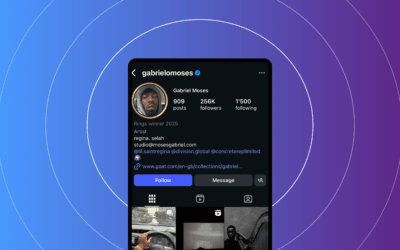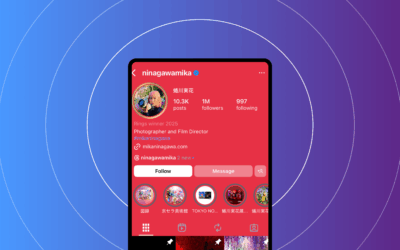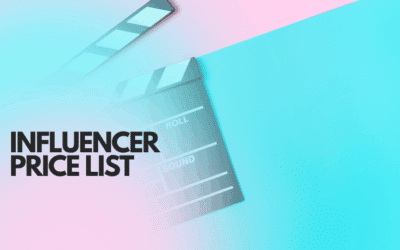Marketing d'influence ou marketing d'affiliation : ROI, AI Content, et comment choisir pour les marques SaaS
Nous nous concentrerons sur le marketing d'influence par rapport au ROI du marketing d'affiliation et sur les réalités derrière le CPA, le LTV et le CAC pour SaaS. Vous obtiendrez des définitions exactes, quand utiliser chaque modèle, comment l'IA change le flux de travail du contenu pour la publication sociale et de type salle de rédaction, et un cadre de décision pratique pour exécuter un pilote propre.
Ce billet examine deux modèles d'acquisition axés sur les partenaires - le marketing d'influence (partenariats de créateurs axés sur la marque et axés sur la portée et la persuasion) et le marketing d'affiliation (relations éditeur/partenaire axées sur la performance et axées sur les conversions suivies) - et explique comment l'IA est utilisée à la fois dans la publication sociale et dans la publication de type salle de presse. L'économie des créateurs continue de se développer, les critères et les budgets évoluant en conséquence, tandis que l'IA générative remodèle la manière dont les équipes conçoivent, rédigent et gèrent le contenu. Dans le même temps, les règles de divulgation exigent clarté et confiance.
Sources : Rapport de référence de l'Influencer Marketing Hub : https://influencermarketinghub.com/influencer-marketing-benchmark-report/ (consulté en septembre 2025) ; McKinsey sur l'IA générative : https://www.mckinsey.com/.../what-generative-ai-can-do-for-your-business (consulté en septembre 2025) ; FTC endorsement guidelines : https://www.ftc.gov/.../endorsements (consulté en septembre 2025)
Marketing d'influence et marketing d'affiliation - définitions, différences fondamentales et utilisation de chaque méthode
Définissons un vocabulaire commun afin que votre équipe s'aligne sur la stratégie et la mesure.
Marketing d'influence : des collaborations payées ou fournies par des produits avec des créateurs (de nano à macro) pour générer de la notoriété, de la considération et de l'influence sur la marque grâce à un contenu authentique sur les plateformes sociales et les canaux appartenant à l'entreprise.
Marketing d'affiliation : des partenariats basés sur la performance avec des éditeurs, des créateurs ou des réseaux, dans le cadre desquels les partenaires perçoivent des commissions pour les conversions suivies grâce à des liens uniques ou à des codes promotionnels.
Structures de rémunération
- Les parrainages à tarif fixe : Typique des posts d'influenceurs ou des bobines où vous payez pour le placement du contenu.
- Produit pour un message : Courant avec les micro/nano-influenceurs ; bon pour l'ensemencement d'UGC et la preuve sociale.
- Partage des revenus/commission : Le modèle d'affiliation classique - pourcentage de la vente ou CPA fixe.
- Modèles hybrides : Honoraires fixes + primes de performance liées aux résultats obtenus.
Points de contact de l'entonnoir et indicateurs clés de performance (cartographie explicite)
- Le haut du tunnel : Portée, impressions, impact sur la marque. ICP : portée, taux de consultation, taux d'engagement, conversions assistées.
- Au milieu de l'entonnoir : Le contenu relatif à la considération incite à l'essai. Indicateurs clés de performance : CTR, engagement dans le contenu, début des essais.
- Bas de l'entonnoir : Les affiliés génèrent des inscriptions/achats suivis. Indicateurs clés de performance : conversions, CPA, CAC, LTV.
Formats de contenu et éditeurs
- Formats des influenceurs : Vidéos de courte durée (TikTok/Reels), vidéos de longue durée sur YouTube, carrousels Instagram, stories, livestreams. Souvent sur les chaînes des créateurs, repurposées pour appartenir à la marque.
- Formats d'affiliation : Articles de blogs, newsletters, revues, sites de coupons, pages de comparaison, podcasts. Généralement sur des domaines d'éditeurs ou des listes d'emails avec des liens traçables.
Conseils pratiques : quand utiliser quel modèle ?
- Choisissez le marketing d'influence lorsque votre objectif est la sensibilisation, l'adéquation produit-marché, l'affinité avec la marque et le contenu de type UGC que vous pouvez réutiliser comme preuve sociale.
- Choisissez le marketing d'affiliation lorsque votre objectif est une conversion mesurable et évolutive, avec des objectifs de CPA serrés et une rémunération à la performance prévisible.
- Utilisez une solution hybride lorsque vous avez besoin d'un renforcement de la marque et de conversions suivies - avec un plan d'attribution multi-touch.
Des réseaux d'affiliation utiles et des tableaux de bord que vous pouvez explorer : CJ Affiliate, Awinet Vente d'actions (consulté en septembre 2025).
| Attribut | d'influence marketing | Marketing d'affiliation |
|---|---|---|
| Objectif principal | Sensibilisation, considération, valorisation de la marque | Suivi des conversions et des recettes |
| Modèle de paiement | Forfait, produit pour poste, hybride | Commission (pourcentage) ou CPA forfaitaire |
| Approche de l'attribution | Souvent assisté ; multi-touch recommandé | Basé sur le dernier clic ou sur un lien ; facile à suivre |
| L'ajustement de l'entonnoir | En haut et au milieu de l'entonnoir | Enchaînement moyen et inférieur |
| Indicateurs de performance clés typiques | Portée, engagement, VTR, impact sur la marque, conversions assistées | Conversions, CPA, CAC, LTV, revenus |
| Formats de contenu | Vidéos de courte durée, YouTube, carrousels, histoires | Blogs, revues, pages de comparaison, bulletins d'information, podcasts |
Marketing d'influence et ROI du marketing d'affiliation - ce qui fait bouger l'aiguille pour une marque SaaS
Pour évaluer le retour sur investissement du marketing d'influence par rapport au marketing d'affiliation, il faut s'aligner sur des formules et des fenêtres d'attribution cohérentes, puis mettre en place un suivi rigoureux.
Formules exactes de retour sur investissement et définitions des indicateurs SaaS
- ROI (campagne) = (Recettes attribuées - Coût de la campagne) / Coût de la campagne
- CAC (coût d'acquisition des clients) = coût total du marketing / nouveaux clients acquis
- LTV (valeur de la durée de vie du client) = recettes moyennes par compte × marge brute × durée de vie moyenne du client
Note : Pour plus de précision, utiliser des fenêtres d'attribution cohérentes et des calculs de LTV basés sur les cohortes.
Notes de source : Investopedia sur le LTV : https://www.investopedia.com/terms/l/lifetimevalue.asp (consulté en septembre 2025) ; Investopedia sur CAC : https://www.investopedia.com/terms/c/customeracquisitioncost.asp (consulté en septembre 2025) ; Awin knowledge : https://www.awin.com/knowledge (consulté en septembre 2025) ; CJ insights : https://www.cj.com/insights (consulté en septembre 2025).
| Entrée | Valeur |
|---|---|
| Coût de la campagne | $5,000 |
| Conversions attribuées | 50 |
| Valeur de conversion (année 1) | $600 |
| Commission/frais par conversion (si affilié) | $100 |
| Sorties | ROI, CAC, délai de récupération |
L'IA dans la création de contenu - comment l'IA remodèle le contenu des médias sociaux et la publication de type journalisme/blog pour les deux modèles.
L'IA générative et l'automatisation changent la façon dont les créateurs et les éditeurs idéalisent, rédigent et optimisent le contenu - mais elles introduisent également des risques d'authenticité, d'exactitude et de gouvernance.
Des rôles concrets pour l'IA
- Idéation : Rechercher des sujets, synthétiser des mots-clés et produire des résumés de contenu qui correspondent à la recherche et à l'intention du public. Exemples : les messages-guides et les ébauches peuvent être affinés par des humains.
- Rédaction et script : Générer des légendes, des scripts vidéo courts et des échafaudages pour les blogs. Gardez un humain dans la boucle pour affiner la voix de la marque et vérifier les affirmations.
- Augmentation de la créativité : Créer ou tester des vignettes, des diagrammes et des concepts de rouleau B à l'aide de modèles d'images/vidéos (par exemple, outils OpenAI, Midjourney, Stability AI).
- Optimisation et tests : Faites tourner les variantes de titres, les méta-descriptions et les longueurs de légendes ; effectuez des tests A/B pour obtenir un effet de levier.
- Modération et conformité : Signalez les affirmations risquées, les problèmes de tonalité ou les informations manquantes avant la publication.
Implications pour le journalisme et les salles de rédaction
- Utiliser l'IA pour la rédaction et la recherche, mais exiger la vérification des faits, l'attribution des sources et l'approbation humaine pour les affirmations sensibles à l'exactitude.
- Maintenir les notes éditoriales et l'historique des versions pour suivre les changements et la responsabilité.
- Les meilleures pratiques de l'Institut Poynter et de l'Institut Reuters guident l'éthique de l'IA dans les salles de presse.
IA + distinctions influenceur/affilié et gouvernance
- Contenu d'influence : L'IA peut accélérer la rédaction de scénarios et l'édition, mais l'authenticité peut être compromise si les créateurs s'appuient trop sur la voix synthétique. Incluez des divulgations et montrez une révision humaine.
- Contenu affilié/éditeur : L'IA peut mettre à l'échelle les critiques et les comparaisons, mais il convient de conserver les citations de recherche, d'ajouter des divulgations d'affiliation claires et d'éviter les préjugés de type "pay-to-play".
Risques et mesures d'atténuation (liste de contrôle pratique)
- Risque d'hallucination : Vérifier les faits pour toutes les affirmations générées par l'IA ; maintenir des processus de validation.
- Divulgation : inclure les divulgations relatives aux partenariats rémunérés et aux sociétés affiliées, le cas échéant ; suivre les orientations actuelles.
- Sécurité de la marque : Utilisez des filtres de sécurité et une révision manuelle pour les sujets sensibles.
- Confidentialité des données : Ne laissez pas les données des utilisateurs dans les invites, sauf si vous avez obtenu leur consentement, et sécurisez l'infrastructure.
Sources : McKinsey sur l'IA générative : https://www.mckinsey.com/.../what-generative-ai-can-do-for-your-business (consulté en septembre 2025) ; OpenAI research and resources : https://openai.com/research (consulté en septembre 2025) ; Midjourney : https://www.midjourney.com/ (consulté en septembre 2025) ; Stability AI : https://stability.ai/ (consulté en septembre 2025) ; Poynter : https://www.poynter.org/ (consulté en septembre 2025) ; Reuters Institute : https://reutersinstitute.politics.ox.ac.uk/ (consulté en septembre 2025).
Cas d'utilisation par secteur - SaaS, médias et salles de presse/blogs
SaaS playbook (tactiques et KPIs)
- Objectifs : inscriptions à l'essai, prospects qualifiés pour le produit (PQL), impact sur le MRR/ARR, demandes de démonstrations.
- Tactiques d'influence : Visites guidées par le fondateur, témoignages vidéo de clients, séries de tutoriels d'intégration ; organisation d'AMA sur YouTube ou LinkedIn Live. Indicateurs clés de performance : début des essais, demandes de renseignements, demandes de démonstrations, coût par essai.
- Tactiques d'affiliation : Sites d'évaluation et comparaisons de logiciels, placements dans des newsletters, places de marché partenaires, éditeurs de coupons pour les promotions ou la saisonnalité. KPI : conversions, CAC, délai de récupération, ratio LTV:CAC.
- Nuance de mesure : Lier les essais aux résultats au niveau du compte (PQLs et expansion) en utilisant le suivi des cohortes.
Médias/édition et salle de presse
- Contenu sponsorisé de type influenceur : Explications de marque et récits de longue durée sur les sites des éditeurs ou les chaînes des créateurs. Indiquez clairement qu'il s'agit d'un contenu sponsorisé.
- Publication affiliée : listes d'achats, pages de comparaison de logiciels et coupons de réduction liés à la demande saisonnière. Conservez l'indépendance éditoriale et séparez clairement les publicités des rapports.
- Gouvernance : Veiller à un étiquetage clair et à la conformité du contenu sponsorisé et des mentions. Pour les lecteurs britanniques, l'ASA fournit des conseils pour les influenceurs des médias sociaux : Orientations de l'ASA concernant les influenceurs (consulté en septembre 2025).
Exemples de scénarios
- Lancement de SaaS : Faites appel à 10 à 20 micro-influenceurs pour des visites authentiques ; intégrez des affiliés et des bulletins d'information avec des pages d'atterrissage personnalisées pour capter la demande en bas du tunnel.
- Salle de presse : Un article explicatif sponsorisé rédigé par le personnel avec des liens d'affiliation contextuels vers des outils recommandés - clairement étiqueté, mesuré séparément de l'éditorial et examiné par le service juridique/conformité.
Liste de contrôle pour l'ajustement rapide
- Si l'objectif principal est la sensibilisation et la narration → marketing d'influence.
- Si l'objectif principal est le suivi des conversions avec contrôle du CPA → marketing d'affiliation.
- Si l'objectif est hybride (marque + conversions) → lancer un pilote mixte avec des KPI mixtes et une attribution multi-touch.
Source : Glossaire des indicateurs SaaS (OpenView) : https://openviewpartners.com/glossary/saas-metrics/ (consulté en septembre 2025).
Mesure, attribution et gouvernance - quand choisir le marketing d'influence ou le marketing d'affiliation ?
Cadre de mesure
- Étape A : Choisissez votre ICP principal (sensibilisation ou conversion) et choisissez un modèle d'attribution aligné sur cet ICP.
- Étape B : Instrumenter le suivi - UTM, pixels, liens d'affiliation et codes promotionnels. Alignez les cookies et les fenêtres d'attribution sur votre cycle de vente.
- Étape C : Effectuer une analyse des cohortes pour relier les cohortes de campagnes à la VLT au fil du temps ; examiner mensuellement, tirer des enseignements trimestriels et recalibrer.
Liste de contrôle de la gouvernance
- Règles de divulgation : Définir où et comment divulguer les partenariats rémunérés et les relations d'affiliation dans chaque actif. Utilisez un langage clair.
- Flux d'approbation : Approuver au préalable les pages d'atterrissage, les captures d'écran et les déclarations. Exigez l'approbation finale du marketing et du service juridique pour les contenus sensibles à la précision.
- Partage des données et confidentialité : Décidez des données de conversion à partager avec les créateurs/affiliés ; respectez le GDPR/CCPA ; ne partagez jamais d'informations personnelles sans accord.
- Cadence d'audit : Examen mensuel des performances ; audits trimestriels des partenaires ; contrôles de la fraude en cas de trafic anormal, de détournement de coupon ou de liens mal étiquetés.
Conformité et sécurité de la marque
- Exemple de langage de divulgation : "Partenariat rémunéré avec [la marque]" et, le cas échéant, "Je peux recevoir une commission si vous achetez".
- Sécurité des marques dans les catégories sensibles : Exiger un examen par deux personnes avant la publication ; maintenir une liste de blocage des revendications et des termes.
Ressources de mise en œuvre : Bonnes pratiques UTM de Google Analytics : Meilleures pratiques UTM (consulté en septembre 2025).
Cadre de décision - cadre pratique en 5 étapes pour choisir entre le marketing d'influence et le marketing d'affiliation pour votre marque SaaS.
- Étape 1 - Définir les critères de réussite
Spécifiez des ICP numériques : par exemple, 500 essais, objectif CAC, objectif LTV:CAC 3:1. Utiliser des modèles prêts à l'emploi pour définir les objectifs. - Étape 2 - Cartographie de l'audience et de l'entonnoir
Faites correspondre le persona à la plateforme et au contenu : Les outils de développement s'alignent sur les tutoriels et les documents de YouTube, les outils pour PME sur les lettres d'information et les pages de comparaison, les entreprises sur les webinaires et les explications d'analystes. - Étape 3 - Évaluer le contrôle et l'authenticité du contenu
Besoins élevés en matière de contrôle → pages d'affiliés/d'éditeurs. Besoins élevés en matière d'authenticité → contenu natif de l'influenceur avec des clients ou des fondateurs. - Étape 4 - Évaluer l'intégration avec les pipelines de contenu d'IA
Décider de l'utilisation de l'IA : idéation, rédaction, augmentation, modération. Exiger l'approbation humaine pour les revendications, les démonstrations et les captures d'écran. - Étape 5 - Plan pilote et critères de réussite
Réalisez un projet pilote de 8 à 12 semaines avec un budget défini, 10 à 20 créateurs ou 5 à 10 éditeurs, et des indicateurs de performance clairs. Définissez des règles d'acceptation ou de refus basées sur le CAC, le lift ou les indicateurs de la marque.
Liste de contrôle d'une page pour la prise de décision (messages binaires)
- Avons-nous besoin d'inscriptions immédiates et mesurables ? → Pensez d'abord à l'affiliation.
- La construction d'un récit et l'éducation des catégories sont-elles la priorité ? → Pensez d'abord à l'influenceur.
- Disposons-nous d'analyses solides pour l'attribution multi-touch ? → Mener un projet pilote hybride.
- La capacité d'approbation juridique/de conformité est-elle limitée ? → Préférence pour les pages des affiliés/éditeurs.
- Disposons-nous d'un flux de travail d'IA robuste avec une assurance qualité humaine ? → Mettre à l'échelle les deux modèles avec plus de confiance.
Arbre de décision (copie de la conception) : Commencez par l'objectif principal. S'il s'agit de sensibilisation, suivez le chemin de l'influenceur. S'il s'agit de conversions, suivez la voie des affiliés. Pour l'hybride, activez l'attribution multi-touch et mélangez les créateurs avec les affiliés, puis mettez à l'échelle les meilleurs programmes.
Manuels de démarrage rapide et modèles tactiques
Modèle de dossier du créateur (prêt à l'emploi)
- Objectif de la campagne (par exemple, 500 inscriptions à l'essai)
- Message principal et supports de valeurs (3 puces)
- Public cible et persona
- Résultats attendus (format, longueur, cadence)
- Indicateurs clés de performance (portée, clics, essais, utilisation de codes promotionnels)
- Exigences légales et de divulgation (copie exacte pour l'étiquette)
- Calendrier d'approbation et contacts
Programme d'affiliation : résumé et conditions
- Structures de commission : Pourcentage du premier paiement ou CPA fixe ; SaaS : 5-30% du chiffre d'affaires de la première année ou $20-$300 CPA en fonction de l'ARPU.
- Guidage sur la fenêtre des cookies : 30-90 jours, correspondant idéalement au cycle de vente.
- Calendrier de paiement : Net 30-60 avec seuil minimum.
- Prévention de la fraude : Validation des liens, rapprochement des conversions ; contrôle du détournement des coupons.
- Exemples de clauses : Clauses de récupération pour les remboursements ; informations obligatoires ; lignes directrices pour l'utilisation de la marque.
- Réseaux à considérer : CJ Affiliate, Awin et ShareASale (voir les sites des réseaux ci-dessus pour plus de détails).
Calendrier de contenu et processus d'approbation basés sur l'IA
- Idéation : Génération de listes de mots-clés/thèmes par l'IA ; examen humain pour déterminer les priorités.
- Rédaction : L'IA produit les premières ébauches ; le rédacteur en chef les révise pour vérifier la voix et les faits.
- Conformité : Effectuer des divulgations et des vérifications de la sécurité de la marque ; stocker les approbations.
- Publication : planifier avec la capture de liens en direct et les UTM ; partager la cadence des rapports.
Exemples de champs du tableau de bord des ICP
- Vues/impressions, taux d'engagement, clics, débuts d'essais, conversions, CAC, revenus attribués, LTV, ROI.
- Intégration d'outils : Tableaux de bord des affiliés, suivi GA4/UTM et votre CDP pour l'analyse des cohortes.
- Les étiquettes du tableau de bord mettent l'accent sur le retour sur investissement du marketing d'influence par rapport au marketing d'affiliation, le modèle d'attribution utilisé et la période de récupération.
Conclusion et prochaines étapes
Le choix entre le marketing d'influence et le marketing d'affiliation dépend de l'intention (sensibilisation ou conversions), de votre discipline de mesure, du degré de contrôle créatif dont vous avez besoin et de la manière dont vous allez gérer l'IA dans le pipeline de contenu. Si vous ne pouvez en choisir qu'un seul, faites-le correspondre à l'objectif commercial que vous devez atteindre ce trimestre et mesurez impitoyablement.
Menez un projet pilote de deux mois en utilisant la liste de contrôle et les modèles de décision - mesurez le CAC, le LTV et les métriques de la marque pour décider du marketing d'influence ou du marketing d'affiliation pour votre prochaine poussée de croissance. Si vous testez une solution hybride, alignez les règles d'attribution et les pondérations des KPI afin que le ROI soit évalué de manière équitable.
FAQ : Les gens demandent aussi
Q1 : Le marketing d'influence est-il du marketing d'affiliation ?
Non, le marketing d'influence et le marketing d'affiliation se chevauchent mais ne sont pas identiques. Le marketing d'influence est axé sur la notoriété du créateur et la promotion de la marque (souvent rémunéré par article ou produit), tandis que le marketing d'affiliation est axé sur les performances et rémunère les partenaires pour les conversions suivies par le biais de liens ou de codes. Voir les règles de la FTC en matière d'endossement pour des conseils sur la divulgation appropriée (consulté en septembre 2025).
Q2 : Les affiliés et les influenceurs sont-ils les mêmes ?
Il peut s'agir de la même personne jouant des rôles différents, mais les affiliés donnent généralement la priorité aux conversions et aux commissions, tandis que les influenceurs donnent la priorité à la création de contenu et à la confiance du public.
Q3 : De combien de followers avez-vous besoin pour les affiliés ?
Il n'y a pas de seuil de followers - le succès de l'affiliation dépend de la pertinence de l'audience, de l'intention de conversion et du type de canal. Les micro-influenceurs ou les éditeurs de niche dont l'audience est réduite mais très engagée obtiennent souvent de meilleurs résultats que les créateurs plus importants en termes d'indicateurs de conversion. Les rapports de référence du secteur confirment cette tendance (consulté en septembre 2025).
Q4 : Quelle est la différence entre le marketing d'affiliation et le marketing numérique ?
Le marketing d'affiliation est un sous-ensemble du marketing numérique axé sur les partenariats de performance ; le marketing numérique comprend tous les canaux en ligne tels que le référencement, la recherche payante, les réseaux sociaux, les courriels et le contenu. Voir l'aperçu de HubSpot pour plus de contexte (consulté en septembre 2025).
Q5 : Quelle est la meilleure solution pour SaaS : le marketing d'influence ou le marketing d'affiliation ?
Cela dépend de l'objectif et de la mesure. Pour la sensibilisation et la preuve sociale, le marketing d'influence brille. Pour des inscriptions mesurables sous un CAC cible, le marketing d'affiliation est souvent plus rapide. De nombreuses équipes SaaS pilotent un hybride et laissent les données sur le LTV et le CAC décider.
Articles sur le marketing d'influence
Des conseils pratiques pour mieux réussir ses campagnes de marketing d'influence
Qui est Gabriel Moses ?
Découvrez Gabriel Moses, l'artiste né à Londres qui mêle mode, musique et patrimoine dans des récits visuels saisissants. De Dior à Johnnie Walker, voyez pourquoi il façonne la culture.
Qui est Mika Ninagawa ?
Découvrez Mika Ninagawa, photographe et réalisatrice visionnaire de Tokyo célébrée pour son art vif, ses récits audacieux, et gagnez à Instagram Rings 2025.
Liste de prix des influenceurs : Ce que les marques paieront en 2025 et 2026
Une liste de prix pour les influenceurs est un ensemble de tarifs et de conditions que les créateurs (ou leurs agents) fournissent - la base pour budgétiser, négocier et prévoir les campagnes d'influence.






